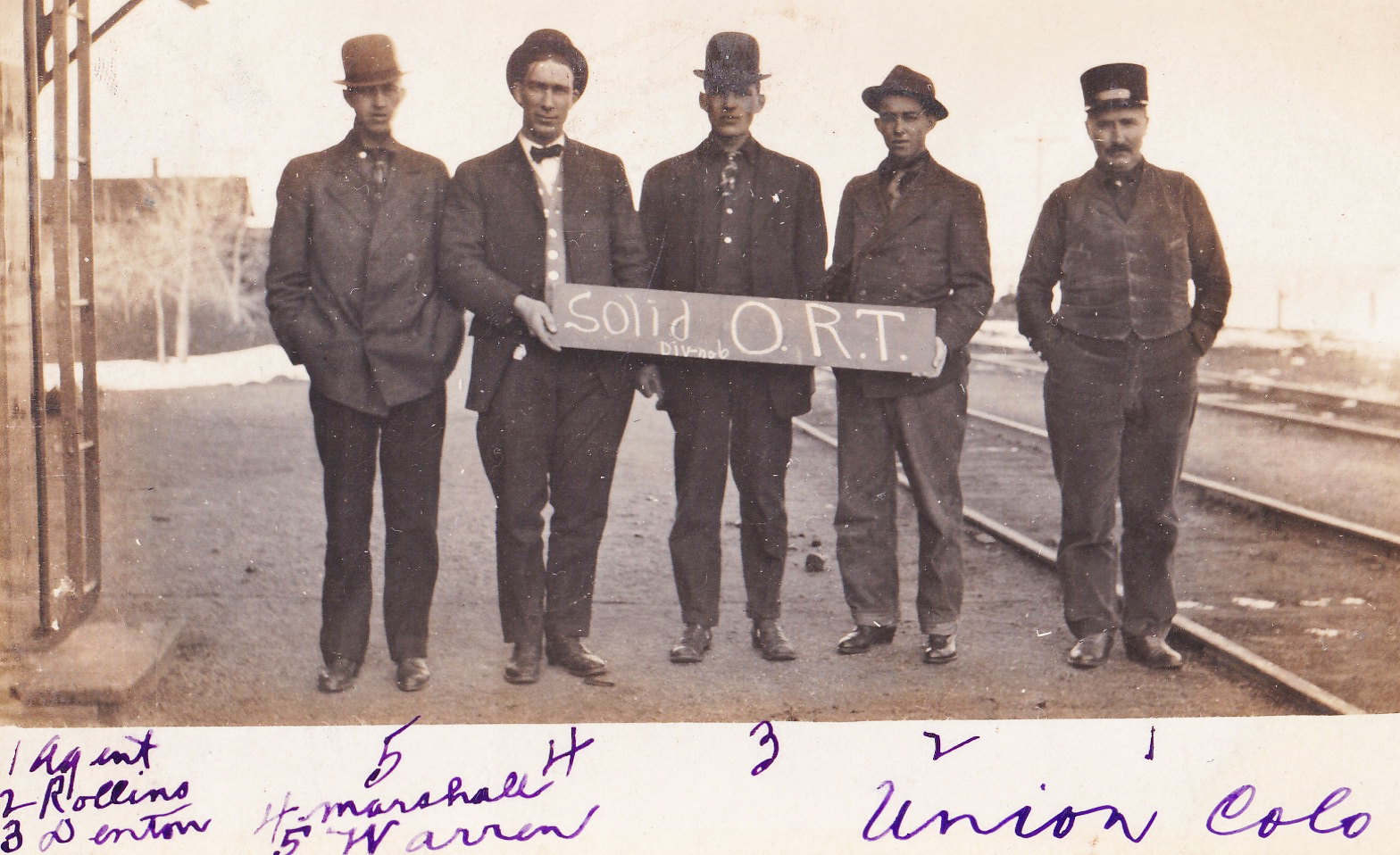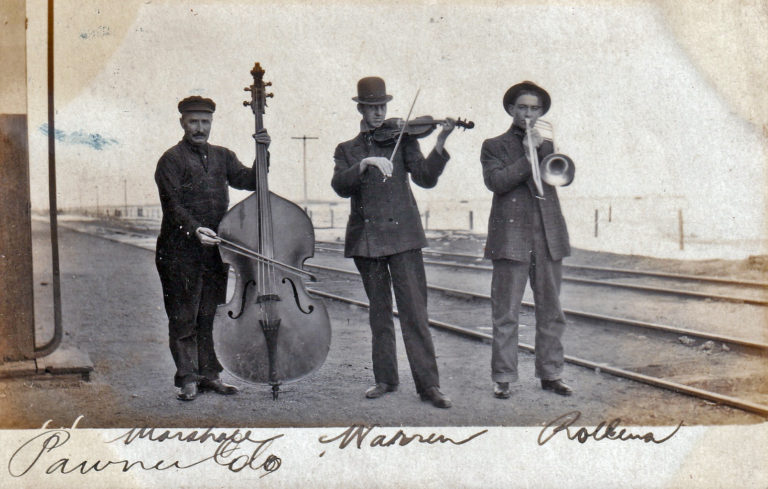This photo postcard commemorates a gathering of railroad employees during Christmas week in 1908, and the card’s author, who signs as “Earl,” identifies the location as Union, Colorado. According to MapQuest, Union is located 12.8 miles north-northeast of Brush. MapQuest says you can get to Union from Brush by taking State Highway 71/Pawnee Pioneer Trails north out of Brush, then taking a right on 2nd Street until it becomes County Road W. 7, which will take you into Union. Other than this MapQuest info, I can find nothing that indicates that Union presently exists as a town.
The card has a Pawnee, Colorado, postmark, and, although I can’t find a record of a town named Pawnee, the book “Colorado Post Offices – 1859 – 1989,” by Bauer, Ozment and Willard identifies a post office by that name, which operated from October 26, 1903, to January 31, 1944. The authors follow this information with the statement, “Town was named Union.”
It seems unusual to have a post office without a town of the same name. But the name “Pawnee” certainly fits Union’s geographic area, for the Pawnee National Grassland, comprising over 190,000 acres, sits a way’s north of Union, and Pawnee Creek, which ran, or may still run, one mile east of where Union sat, has its source at the confluence of North and South Pawnee Creeks in the Grassland. The name “Pawnee” may be a lasting tribute to what some say was the first Native American tribe to inhabit the Grassland, arriving there around 1200 A.D.
The names “Union” and “Pawnee” may have been used interchangeably. As indicated above, “Earl” identifies the location of this photo as Union, Colorado, but identifies the location for the next postcard photo as Pawnee, Colorado, even though the second photo appears to have been taken in the same immediate area as the first photo.
“Earl” has addressed the card to Miss Elsie Miller in Crete, Nebraska. Identifying the weekday, time and date of his message as Monday, 11:30 a.m., on January 4, 1909, he writes: “Dear Elsie, This is my latest photo. What do you think of it, it’s the bunch that was here Xmas week. We had a great time.” Note the numbering of the men and their corresponding identities beneath the photo.
The letters “O.R.T” on the sign being held by the men is the acronym for the Order of Railroad Telegraphers union, which was established in the late 1880’s to promote and protect the interests of railroad telegraphers. (In the photo, the notation on the sign below the acronym, i.e., “DIV—no 6,”probably referred to a unit within the union.) These union men are clearly standing next to railroad tracks, so perhaps they’re at the Union railroad station. Earl identifies the man at the far right as “Agent,” and thus this man might have been the agent for that station. (The station agent was the person in charge of the station, and in a small town like Union, the job most likely included selling tickets, handling baggage and operating the telegraph.)
The photo postcard presented below – i.e., # 2 of 2 — was also mailed by “Earl” to Elsie Miller one week after he mailed the first one. My wife, Bev, did some research and discovered that a Frank Earl Denton married Mary Elsie Miller in Crete, Nebraska on May 15, 1912. The Crete News article reporting the wedding identified Denton as a station agent for the Denver and Rio Grande Railroad in Dolores, Colorado, and Miller as a stenographer at the creamery in Fairmont, Nebraska (which lies about 45 miles west of Denton.) Earl and Elsie would make their home in Dolores. The chances are pretty small that a railroad employee named Earl, who sent two postcards to an Elsie Miller in Crete, Nebraska, in 1909, would not be the same person as the railroad worker named Frank Earl who married Elsie Miller of Crete in 1912. It becomes virtually impossible to claim coincidence when a look at the name of the man with the number #3 in the first photo reveals it to be “Denton.”
Mary Elsie Miller, born in 1887, was the daughter of Elmer Edward and Mary Agnes (Ross) Miller. The Millers moved from Illinois to the Crete, Nebraska area, where they farmed.
Frank Earl Denton (from here on out I’ll refer to him as Earl), born in 1885, originally hailed from the Nebraska town of Denton, a town named for his grandfather, Daniel M. Denton.
In 1866, Daniel M. Denton, his wife, Amelia Talcott (Adams) Denton, and their five children, including Frank Earl’s father, Frank Roselle Denton, came out to Lancaster County, Nebraska, from Ohio to homestead. Daniel became a successful farmer and later was a cattleman. When the Dentons arrived in Lancaster County, there were only two other families in the immediate area. In 1891, the Dentons, those two families and perhaps others, platted a village and Daniel was honored by having the town named after him.
Earl’s father, Frank, also took up farming. Earl grew up on the farm and of course was expected to help work the place. But by 1907, he was working as a railroad telegrapher at the train station in Denton. This fact was reported in the October 1907 issue of the ”Railroad Telegrapher,” an O.R.T. publication which kept union members informed on a variety of topics germane to union issues, but also included reports on the doings of its members. The item about Earl’s doings was short and read: “Bro. (probably an abbreviation for Brother) Earl Denton, of Denton Station, Sundayed (sic) at Crete.” Crete of course is where Elsie Miller lived! I did some research and discovered that Crete and Denton are just 13 miles apart. This would be a short trip on a train, and the Burlington Railroad in fact connected the two towns. Given the proximity of the two towns, there’s a good chance Earl and Daisy had known each other at least a couple of years before Earl wrote her the postcards.
More on the O.R.T.
The Order of Railroad Telegraphers limped along for the first ten or so years of its existence. However, a turning point was reached with the election of George Estes as chairman of the Telegraphers’ San Francisco Division in early 1899 – he was hailed as a “a ‘Moses’ who was leading the telegraphers out of the ‘wilderness.’”
Estes, in a 1938 interview, described a management technique used by railroad companies to discourage union memberships:
“If the ‘Company’ discovered an employee dallying with the notion of joining the Order, they straight-way trumped up some excuse for severing him from his job. They did a neat job of it, too. Here’s how they did it: They never discharged an employee because of union activity. It was always because of ‘reduction of force,’ ‘reorganization’ or other reason. However, in giving him his clearance papers — any employee leaving the service of a railroad was given clearance papers — they employed a secret code, known only to railroad officials, which as effectively black-listed him as if it were written in plain English. The paper on which the clearance was typed had a water-mark. The water-mark was a crane, a bird with long legs which extended nearly the length of the paper. If there were no red lines crossing the crane’s legs or neck, the clearance was exactly what it appeared to be on the surface — a recommendation to be honored by any road in need of the applicant’s services. But if the red lines were there, although the wording of the clearance was identical with the honorable one, the applicant could as easily obtain work on a railroad as fly to the moon.”
In 1965, the O.R.T. changed its name to the Transportation Communications Employees Union and then four years later merged into the Brotherhood of Railway & Airline Clerks, Freight Handlers, Express & Station Employees (BRAC). At the time of the merger, O.R.T. had 30,000 members.
Earl and Elsie Move to Florida
In 1913, Earl and Elsie would move to Miami, Florida, where Earl became a construction contractor and carpenter. They would live out their lives there, with Frank passing away at age 70 or 71 in 1956. Elsie would live until 1970, passing away at the age of 83. Their remains are interred at the Flagler Memorial Park in Miami.
REFERENCES:
- “An Archaeological Survey of Selected Tracts in the Pawnee Buttes Region, Weld County, Colorado,” by Kevin D. Black, with a contribution by Aaron V. A. Theis, May 2017. Sponsored by History Colorado, Office of the State Archaeologist of Colorado, Program for Avocational Archaeologic Certification, Denver, CO, at https://www.historycolorado.org/sites/default/files/media/documents/2018/paac_pawneebuttes_final.pdf
- “Bridge Washed Out,” June 3, 1904, Brush Tribune, Colorado Historic Newspapers collection at https://www.coloradohistoricnewspapers.org/?a=d&d=BRT19040603-01.2.14&srpos=8&e=–1900—1920–en-20–1–img-txIN%7ctxCO%7ctxTA-pawnee+and+union——-0——
- Colorado Post Offices – 1859 – 1989, by Bauer, Ozment and Willard, 1990, published by the Colorado Railroad Museum
- “Denton,” The Miami Herald dated April 19, 1970, www.newspapers.com at https://www.newspapers.com/image/622979629/?article=fbe70c1a-30b0-468b-b2a1-b30dba68f2b8
- Denton-Adamson Family Tree at www.ancestry.com
- “Denton-Miller,” The Crete News dated May 23, 1912, www.newspapers.com at https://www.newspapers.com/image/673161296/?terms=denton-miller&match=1
- Distance between Cities at https://www.distance-cities.com/distance-denton-ne-to-crete-ne AND https://www.distance-cities.com/distance-fairmont-ne-to-denton-ne
- Find a Grave for Amelia Talcott Adams Holliday at https://www.findagrave.com/memorial/206289393/amelia-talcott-holliday
- Find a Grave for Frank R. Denton at https://www.findagrave.com/memorial/11057122/de
- Interview with George Estes on November 28, 1938, Library of Congress at https://www.loc.gov/resource/wpalh2.29070630/?sp=11&st=pdf&pdfPage=24
- “Order of Railroad Telegraphers,” www.wikipedia.org at https://en.wikipedia.org/wiki/Order_of_Railroad_Telegraphers?msclkid=3151bc1ace5411ec9f46cadc8f2a342d
- “Pawnee Creek (Colorado),” Wikipedia.org at https://en.wikipedia.org/wiki/Pawnee_Creek_(Colorado)
- “Pawnee National Grassland, NE of Greeley,” Forest Service, U.S. Department of Agriculture at https://www.fs.usda.gov/recarea/arp/recarea/?recid=32170&actid=34
- “Radical Heritage: Labor, Socialism, and Reform in Washington and British Columbia, 1885 – 1917,” by Carlos A. Schwantes, page 143; published in 1979 by the University of Washington Press at https://www.google.com/books/edition/Radical_Heritage/6KYpDAAAQBAJ?hl=en&gbpv=1&dq=Radical+Heritage:++Labor,+Socialism,+and+Reform+in+Washington+and+British+Columbia,+1885+%E2%80%93+1917&printsec=frontcover
- “Railroad Job Descriptions,” The NEGenWeb Project” at http://www.usgennet.org/usa/ne/topic/railroads/job.html
- “Railroads of Lincoln and Lancaster Co” at https://llcgs.info/cpage.php?pt=51
- “Resource Guide to the Pawnee Grasslands,” by Jim Kielsmeier, et al., 1975, Colorado Outward Bound School at https://files.eric.ed.gov/fulltext/ED139566.pdf
- The Railroad Telegrapher, Volume 24, Part 2 dated 1907, Google Books at https://www.google.com/books/edition/The_Railroad_Telegrapher/DnEWAAAAYAAJ?hl=en&gbpv=1&dq=frank+earl+denton+telegrapher&pg=PA1720&printsec=frontcover
- Wolf Family Tree at www.ancestry.com


